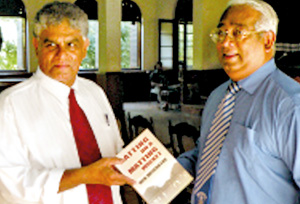Neil and I have spent many hours in the last thirty years and more, recalling cricketing exploits and episodes, and it has always been the passion with which he has been able to relate an incident which strikes you.
His recollection of events is amazingly vivid and his attention to detail distinguishes him from most sports writers. Perhaps his legal background has much to do with his ability to embellish a story without losing the message. If one were to look for a clear message in this collection of articles spanning a period of eight years, it is that Sri Lanka has so much to be proud of as a sporting nation and moreover, it has a tradition of appreciating good performers from whatever background they come. Neil focuses on several champions especially school cricketers, whose performances have become legendary.
 |
| Author Neil Wjeratne with his book |
Neil has done tremendous research in relation to both Cricket and Rugby and has publications on both subjects in Sinhala and English, which is a truly remarkable achievement and this, his latest work in English is bound to be a best seller.
Neil is a prolific writer and has received accolades both n Sri Lanka and India. The book is one of many dozen publications brought out by Neil, who one finds hard to believe, is a busy lawyer with some demanding clients.
To me it was a veritable walk down memory lane. He talks of the exploits of Jack Anderson, who is treated by generations of Antonians as a demi-God and refers to some matches in which I was fortunate enough to figure. One was the famous fight back by the Antonians against Kehelgamuwa with the Joseph brothers both scoring centuries. Another was the match in which, the Peterite Le Mercier, who had probably never scored a fifty in his entire career, suddenly became a demon with a weapon for a bat and flogged our bowling for a mind boggling score of 239.
Yet another match I recall was when Bumper Perumal skittled out St. Anthony’s at Darley Road in 1962. Neil mentions that Bunny Stevens was bowled for 0, but does not refer to his replacement the number three, the writer. I was just 16 and I struggled for an hour against some ferocious bowling on the matting at Darley Road, and cannot forget my exit on a stretcher after getting hit on the hip and falling on the wicket bowled ‘Bumper Perumal’ for 23.
Neil’s story on Bradman’s visits to Sri Lanka, show how discerning and sophisticated Ceylonese cricket enthusiasts were even in those early years. Neil opines that even in the Thirties the game appealed to and was appreciated irrespective of class. He points out that it was not the same with other sports, especially with Rugby, where the class distinction seemed to prevail.
Neil relates his meeting with the famous Gopalan after whom the Gopalan Trophy was named. An interesting account of the fixtures is given culminating with the match in 1983 when Duleep Mendis played an epic innings of 189 and Asantha de Mel who went in at no.9 was also able to score a century.
One Chapter is devoted to matches between St. Joseph’s College and Trinity College and the original article was written to mark the centenary of the encounters. The inaugural match had been part of a ‘tour’ of Colombo in March 1908 by the Trinity team with the Josephian encounter being the final fixture. The match had ended with an innings win for the Josephians.
His chapter on Rajiv Benedict is outstanding. In his first Sara Trophy match Rajiv had taken 9 wickets for 24 including a hat-trick. Rajiv also had the remarkable record of a hat-trick in each innings for the Tamil Union in a Donovan Andree Tournament match. Neil has also written two chapters on two Josephian sportsmen who will be long remembered.
Fred Perera and Fairlie Dalpadado, who were not only great cricketers, but were multi-talented sportsmen and known in other sports spheres as well.
Sports lovers will find this book absorbing and one which they would wish to keep in their personal collections. Cricket lovers would find the book difficult to resist. |


